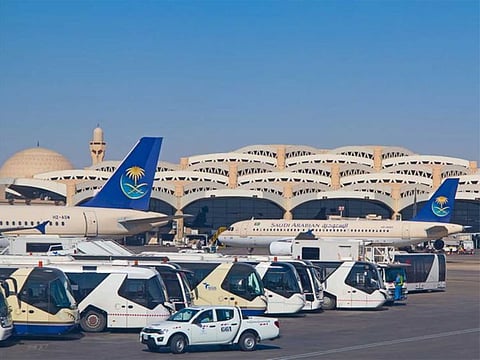New Saudi carrier Riyadh Air will not have it easy on high intensity Middle East routes
UAE, Gulf airlines have added flights, been aggressive on pricing on short-haul routes

Dubai: Saudi Arabia’s brand new national airline, Riyadh Air, will fly into immediate and intense competition with UAE and Gulf carriers already scaling up services into and out of the Kingdom. Riyadh Air was formally announced as Saudi Arabia’s new flagship earlier this week and tasked with the mission to expand its presence on high visibility long-haul routes.
But intra-Gulf and other shorter haul destinations could still matter for the world’s newest carrier. (The actual launch dates for the airline have not been confirmed as yet.)
“The presence of Riyadh Air will energise the aviation sector, stimulate competition, and improve connectivity to secondary cities,” said John Grant, Chief Analyst at global travel data provider OAG. “Although you could argue that this is already happening through the rapid advancements of low-cost carriers (like Wizz Air Abu Dhabi) in the Middle East.
“The advantage I can see is that they (Air Riyadh) will have a huge domestic market that they can access which (other Gulf) carriers haven’t. Turkish Airlines is a close competitor.
“To begin with, Riyadh Air will have a limited network, and perhaps limited access to peak slots at some airports around the globe. It will be a long time before this carrier is a serious network rival to Emirates, for instance.”
In the last year or so, UAE based airlines have quickly moved in to raise flight frequencies on popular routes. While Emirates keeps expanding the number of global cities it flies to using the Airbus A380, new carriers such as Wizz Air Abu Dhabi and Air Arabia Abu Dhabi have been locking in new destinations to their networks – and been aggressive with their fares while doing so. UAE carriers have also been adding more flights to Saudi Arabia.
In for the long haul
Riyadh Air, which is owned by the Saudi wealth fund PIF, has started to place orders, with Boeing winning big with its 787 Dreamliners. With the new airline, PIF will play the long game, even as Saudi Arabia creates more reasons to visit the Kingdom through its ‘giga-destinations’ such as Neom City and AlUla.
Travel agents and frequent travellers to Saudi Arabia are hopeful airfares to and from the Kingdom will remain affordable once Riyadh Air makes its entry. “It will take time for the airline to have an actual impact on airfares,” said an agent. “Travellers will have an additional option and - eventually - competitive fares.”
Travel industry sources say that fares would remain slightly above average on the Saudi sector until Riyadh Air finds a strong foothold. Along with a forecasted tourism boost, Saudi-bound connectivity would improve during the Hajj and Umrah seasons, depending on the offers the new airline provides.
Make its presence felt on Saudi-India routes?
“While certain sectors such as India-UAE have hit saturation point due to exhaustion of traffic rights, route expansions from Saudi Arabia to India are a huge potential market. It would serve Saudi Arabia's Indian expat community well." - Aviation analyst
Domestic competition
Riyadh Air will also have to factor in how it adjusts to the operations and networks already in place for Saudia, the hitherto national airline. Not just that, there are other domestic carriers such as flynas and Saudia’s subsidiary – flyadeal – that have ‘strong’ reach from Saudi Arabia to the UAE.
Saudi Arabia adopted a dual-hub airline strategy to boost visitor numbers from 100 million to 330 million by 2030. Saudia will operate from Jeddah and the new airline from Riyadh.
Will Riyadh Air take over some routes and overseas slots from Saudia to give it the crucial profile in the initial phase of the launch? Or will the new airline build up the services from scratch?
All options could be on the table – but one thing is clear, competition will be nothing short of intense.
Saudi Arabia's pilot needs
Saudi Arabia has the means to address its pilot requirements through the steady expansion of its training infrastructure. There are four pilot training organisations in Saudi Arabia, 'each in expansion mode'. "These are in their early growth stages and could support Saudi Arabia’s demand for pilots and potentially train more of the training requirements of other GCC airlines,” said Maximilian Buerger, the Managing Director of AFM.aero and Aviationfly.com. Jeddah-based Prince Sultan Aviation Academy placed an order for more pilot simulator training equipment last year to expand its training capacity, while AeroGuard Arabia, a flight school based near Jeddah, is a partnership between a Saudi entity and AeroGuard Flight Training Centers, one of the biggest US based businesses in this space. Riyadh also saw the start of a new flight school last year, with Tayaran (The National Aviation Academy) being formed by prominent stakeholders, including Saudi Aramco and Saudia. There is OxfordSaudia, which has the most 'extensive flight school in the Middle East when measured by training aircraft numbers', Buerger added.
Sign up for the Daily Briefing
Get the latest news and updates straight to your inbox



